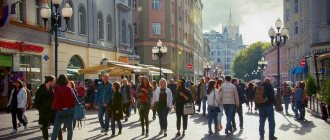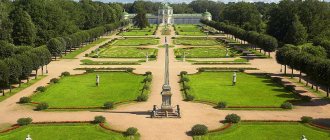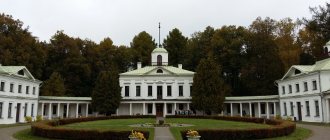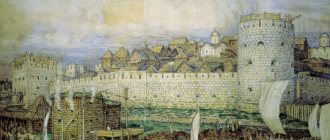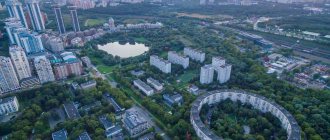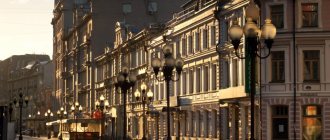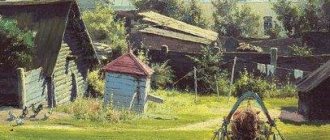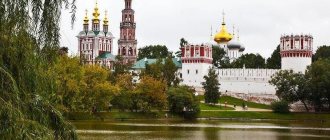History of Moscow Arbat
The first mention of Arbat appeared in Moscow chronicles at the very end of the 15th century.
Initially, Arbat meant a certain territory located to the west of the Kremlin between Ostozhenka and Nikitskaya streets. The street became a link connecting the heart of Moscow with the western lands. The royal chariots marched along the Arbat, enemies approached the city along it, and along it they ran back. Arbat acquired its modern shape a century later, when this part of Moscow was completely built up with wooden houses. It’s not for nothing that the nearby alleys and streets bear the names of craftsmen - artisans and the Tsar’s Kremlin servants settled here in entire farmsteads. Arbat was inhabited by carpenters, carvers, and cooks. Representatives of the same professions preferred to live in the same territory. Their names came from the professions of the artisans who inhabited this or that lane.
Arbat - where did the name come from?
The origin of ancient names always gives rise to a lot of controversy, because reliable sources are rarely preserved. Discussions related to the origin of the name also continue around Arbat. The fact that the word “Arbat” came from a foreign language is virtually beyond any doubt. But there are different opinions about the specific origin:
- One of the main versions is considered to be the origin of the word from the Tatar “arba” and associates it with the craftsmen’s “cart” area, located near the territory of Arbat. Nevertheless, many opponents of this opinion believe that the craft settlement was formed later than the era when the first mentions of the future symbol of Moscow had already appeared. Also, the word “cart” in the center of the capital had nowhere to come from - there was never a preference for this type of cart.
- A well-known Moscow historian suggested that the name was formed from the word “hunchbacked,” since on ancient maps of Moscow the street was not drawn as a straight line, but with a certain degree of curvature.
- There is an opinion that, being a craft district, Arbat traces the history of its name from the German “arbeiten” - “to work”, but there is no real basis for such speculation.
- Most historians are inclined to believe that the name Arbat comes from the Arabic word “rabad”, which means “suburb”.
Be that as it may, the name took root and was loved by Muscovites. And even under Tsar Alexei Mikhailovich, when Arbat was ordered to be called Smolenskaya Street, none of the residents wanted to obey this decree.
“So I’m home!”
Alexander Sergeevich Pushkin also lived on the Dog Square, and even wrote his message to Siberia there. Lenin’s mother, Maria Ulyanova, also lived in the wooden house for some time, and Lenin himself stayed with her. Sobachka also remembered Marina Tsvetaeva; her daughter Irina died here in 1920.
“On one of Molchanovka there was a famous pub,” continues M. Derzhavin. - They called it Vavilovka - it rested on the fence behind which the house of Academician Vavilov was located. The pub occupied a small, neat house the size of a construction trailer. But it was a very cozy and warm place. All the famous “faces” of Soviet cinema were among the regulars there. I remember how we boys came there in the winter and were treated to lemonade and sweets. The actors drank vodka and beer. There was a snack on the counter - mountains of jars of crab. Pyotr Repnin (everyone remembers him from the film “The Foundling,” where he played Faina Ranevskaya’s husband, the same Mulya who was making her nervous) often “aggravated” things there so that the actors of the Vakhtangov Theater escorted him home, having previously turned the stone on his ring inward palms so that no one attacks or steals.
After school, we usually walked along Sobachka and went to Arbat to watch the Soviet leaders rush past from the Kremlin with the breeze. Comrade Stalin drove a black car, the windows were always curtained. And along the road stood identical guys in blue coats with black fur and reported on the radio: “The owner is coming”... When I grew up, I saw Semyon Budyonny driving by. He always sat in the front seat next to the driver. And we waved to him. Budyonny smiled and saluted. Much later, when I had already become a famous artist, I once confessed to him: “Semyon Mikhailovich, I waved to you when you were passing in the Arbat area by car.” He laughed: “Son, that’s where I got home!”
They were going to remove the Dog back in 1935. At first the war got in the way, then, apparently, they didn’t get around to it. But in 1962, city planners finally got to it. “The dog park interfered with the construction of the New Arbat,” Mikhail Derzhavin is sure. “And those people who planned to build it at any cost had nowhere to go. On the one hand, Moscow would now be suffocated by the fumes of numerous cars in those old streets. But, on the other hand, there were amazing mansions there. If they had lived to this day, the center of Moscow would have had a beautiful old square, similar to those that decorate many European capitals.”
Arbat from century to century
In the place where the Arbat now exists, before its appearance there were earthen fortifications. The ditches protected the approaches to the city in the Smolensk-Mozhaisk direction. Settlements appeared here during the time of Tsar Ivan III, and the first inhabitants were the royal grooms. The memory of this is preserved in the name of one of the most famous Arbat lanes - Starokonyushenny. The craft lifestyle on the territory of Arbat remained for about two and a half centuries.
XVIII century
When at the beginning of the 18th century there was a strong fire in the central part of Moscow, which destroyed a good part of the Arbat buildings, the artisans left these areas and moved to the nearby district. During restoration, the street was expanded, and mansions of the capital's nobles began to be built up. Representatives of the most famous Moscow aristocratic families have their eyes on the Arbat lands. Princes and counts began to walk around Arbat and the surrounding area - the Sheremetevs, Obolenskys, Trubetskoys, Golitsyns. During its aristocratic days, it was not for nothing that this area was called the “nest of the nobility” - out of the fifty buildings that existed on the Arbat at that time, no less than forty belonged to the highest nobility. Social life was in full swing here, balls and receptions were held. In the 18th century, there were practically no shops and trading houses on Arbat, but noble mansions were surrounded by luxurious gardens.
19th century
Aristocracy has always been inextricably linked with education and culture. Arbat began to attract writers, poets, and artists. Over the years, Pushkin, Blok, Tolstoy, Chekhov and other famous authors lived and worked here. A wooden theater was built on Arbat Square according to the design of the famous Italian architect Rossi. Contemporaries called this building the standard of the Melpomene temple - columns, galleries, interior decoration and excellent acoustics made the theater popular and visited. The last performance was performed on the eve of Napoleonic invasion of the capital. Like other areas of Moscow, Arbat suffered greatly from the fire of war, but after a few years it returned to its former greatness.
At the end of the 19th century, the capital's nobility, which had taken a liking to the district, increasingly began to move to suburban mansions and other areas of the expanding Moscow, and the streets and alleys were populated by a motley Moscow intelligentsia. Shops, restaurants, taverns, canteens began to appear on Arbat, and apartment buildings were built. A tram began running along the street, first horse-drawn and then electric.
XX century
With the advent of Soviet power, the former princely mansions turned into communal apartments, into which the builders of a new, communist life moved in. Arbat turned into a faceless and gloomy gray street, and the government route to the Kremlin passed along it.
In the 60s of the last century, Kalininsky Prospekt was built almost parallel to the ancient street, relieving the Arbat from traffic. Since then, people have unofficially designated the two streets as Old and New Arbats. When, in post-perestroika times, the names of political figures disappeared from the names of Moscow avenues, streets and alleys, there was no need to even think about what name to give Kalininsky Prospect. It became New Arbat.
In the second half of the 20th century, they planned to make Arbat pedestrian, which was implemented in a decade and a half. The gray houses were repainted in pastel colors, the entire street was covered with tiled paving stones and the famous Arbat lanterns were installed. In the central part of Moscow, Arbat has become a favorite place for walking. The pedestrian area was filled with street artists and musicians, numerous cafes opened here, and various events began to be held.
XXI Century
Today Arbat still has the status of a pedestrian street. On Arbat you can buy books, souvenirs, paintings and other gifts to remember Moscow. Several years ago, the city authorities began another reconstruction, but the project has not yet been fully implemented. It is also planned to make Arbat a “non-smoking street”.
Photographs of Arbat from the 19th century
The location of Arbat was such that mainly working and service people settled here. These are various artisans, traders, archers. This is clearly demonstrated by the names of the neighboring streets - Starokonyushenny Lane, Plotnikov Lane, Kamennaya Sloboda, Serebryany, Kaloshin Lanes...
However, gradually this area increasingly attracted the attention of the boyars and nobility. Ordinary people are gradually being pushed out of the area, and in their place beautiful noble houses, decorated with magnificent interiors, appear. Arbat was severely damaged by fire during the Napoleonic invasion. Many houses were burned or destroyed, although over time new houses were built on the old site.
At the end of the 19th century, the Prague tavern was built
Sights of Arbat
While walking along Arbat you can see many memorable places associated with its history - monuments, museums, architectural structures. The Arbat begins from the square of the same name with the building of the Prague restaurant, in which Leo Tolstoy once read excerpts from his “Resurrection,” and ends with the buildings of the Ministry of Foreign Affairs near Smolenskaya Square. Also on Arbat you can get to interesting museums and see other attractions.
- The Khudozhestvenny Cinema is the first cinema venue in Moscow, built in pre-revolutionary Russia. Created only to show films, the Arbat cinema became so popular that a few years later it was expanded to almost 1,000 seats. The premieres of the first Soviet films “A Start to Life” and “Battleship Potemkin” took place here.
- The Museum of Optical Illusions is a unique room where dozens of interactive paintings literally come to life. The perception of each picture depends individually on each person. In the interactive museum you can become a participant in art installations and take a photo as a souvenir.
- The Perfume Museum offers you to plunge into the world of legendary scents that our grandmothers still remember. On a tour of the museum, you can learn interesting facts about the creation of perfume masterpieces and taste scents from the museum’s library. Collectors of vintage perfumes gather here and there is a store where you can buy rare items.
- The monument to Bulat Okudzhava was erected on Arbat at the beginning of this millennium. The large-scale composition includes two bronze arches, a table and benches, which are installed on a cobblestone street. Through one of the arches “comes out” a sculpture of the legendary poet, whose life and work are most closely connected with Arbat. The composition symbolizes a piece of the Arbat courtyard, in one of which Okudzhava spent his childhood.
- The graffiti wall of Viktor Tsoi was created by fans in memory of the untimely departed rock singer in the year of his death. One of the sides of the house, facing Krivoarbatsky Lane, is painted with drawings and inscriptions. They tried to paint over the wall many times, but loyal fans restored it again. Today, rock musicians, hippies and other representatives of youth groups gather here, playing guitars and singing the poet’s songs.
- The monument to Pushkin and Natalie has existed for about 20 years and is installed opposite the poet’s house-museum. The elegant and sophisticated sculptural composition has managed to fall in love with both Moscow residents and tourists. The monument recreates the scene of the poet’s marriage, when he brought his young betrothed to his apartment on Arbat.
And on Arbat you can visit a sweet shop, go to the theater named after. Vakhtangov or relax at the Hard Rock Cafe.
Lions and dogs
Even under Ivan the Terrible, guardsmen lived in the Arbat area. A Streltsy settlement was also built there. The royal dog yard was also located nearby—hence the Dog Playground got its name. It was first recorded in the urban planning plan of the capital in 1818.
“My childhood was spent on Arbat, on Malaya and Bolshaya Molchanovka, and on the famous Dog Playground,” actor Mikhail DERZHAVIN told AiF. — I live in the house of the Vakhtangov Theater, in the next entrance is the Shchukin Theater School. The corner of the building directly overlooked the Dog Playground. It was a unique place in Moscow. I even have a photograph of the Dog from the beginning of the last century - back then troikas still traveled there. The area was paved with cobblestones, in the middle - behind a cast-iron fence - a public garden. There was also an obelisk made of reddish stone. On it, like on many old Arbat buildings of the century before last, the long elongated muzzles of lions have been preserved. Someone guessed they were dogs. But I specifically clarified that they really were lions.”
According to some versions, this obelisk once served as a fountain. Some historians believe that it was built by the descendants of the Russian philosopher Alexei Khomyakov. Others are sure that it was the most ordinary drinking bowl for horses. In Soviet times, a story was told that some nobleman built an obelisk in memory of his deceased dog.
“To the right of my house was the 1940s Museum. and the Institute. Gnesins,” recalls M. Derzhavin. — Opposite there was a famous kerosene shop. Before the Great Patriotic War and immediately after it, many Muscovites still used kerosene stoves. Nearby on Arbat there was a maternity hospital named after. Grauerman, Mark Zakharov, Alexander Shirvindt, your humble servant, were born here, Andryusha Mironov was also born here. And there wasn’t a single building on Sobachka without memorial plaques that mentioned famous people who lived there.”
How to get to Arbat
Arbat Street is located near the Moscow metro stations "Arbatskaya" and "Smolenskaya", so it will not be difficult to get to Arbat on your own. Both stations are located on the blue and blue metro lines and you can get off at the one that is closer along the route. When you exit on Arbatskaya, you will find yourself at the beginning of the street, and on Smolenskaya, you will end up at its end.
You can also get to Arbat by ground public transport - buses and trolleybuses, and from Red Square you can walk on foot, following the streets Znamenka or Vozdvizhenka to Arbat Square.
Soviet era photographs
In Soviet times, Arbat was essentially an ordinary city street, the same as hundreds of others in the center.
Currently, Arbat has lost its ancient attractiveness. Here you can see only a few churches and old noble houses. But the old Arbat spirit still hovers here. To some extent, this is facilitated by the transformation of Arbat into a pedestrian zone. There are no modern offices, no cars roaring noisily down the street, no working industrial enterprises. This modern corner of old Moscow.

